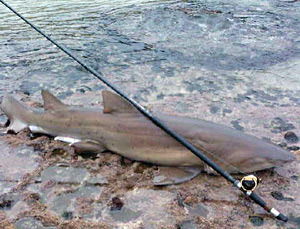taken from Where There Be Fins [http://wheretherebefins.tumblr.com/]

The Grey Nurse Shark is a globally threatened species. The International Union for the Conservation of Nature (IUCN) hold this species at a status of ‘Vulnerable’ on a global scale. This essentially means that the species is teetering on the brink of endangerment. If you want some figures, the species has reduced by up to 50% within the last 10 years or 3 generations. This is not a great sign to start.
However this article will focus more on the population native to SE Australia. This population is now down to under 500 individuals, has dropped by 90% in the last 10 years and still dropping. This population is now classified as ‘Critically Endangered’ - a shocking fact when you consider that the species was first protected back in 1984 by the New South Wales government. So why the continual drop?
Well firstly there are behavioural issues to consider. Some species of shark migrate huge distances, crossing oceans, breeding with individuals on different sides of the globe. This keeps the population very fluid, very dynamic - meaning that there is large amounts of migration, fished individuals may be replaced by incoming adults ready to breed and so populations can survive fishing pressure. What it also means is that there is a huge gene pool, resistant to disease and inbreeding. This unfortunately is not the case for the Grey Nurse.
If anyone has ever dived with these sharks, you’ll notice that they are fairly sedate, sticking to the bottom and moving in repetitive cycles - not your huge ranging pelagic sharks like Threshers or Oceanic White Tips. Any DM or dive guide will tell you that in certain seasons you can find them in the same place every day. So from the outside they seem to have a degree of site-specific preference.
This was found to be true from one study in 2006.
This was the first time that distinct populations were identified between east and west Australia. The degree of genetic isolation between the two populations implied there was possibly zero dispersal between the two populations, certainly none between South Africa and Australia. Also when you look within the populations, the genetic variation for the east Australian individuals was notably low.
As if this wasn’t enough, this species also breed slowly producing 1-2 pups at a time only every 2 years. The reason for this low number is the phenomenon known as Adelphophagy or Uterine Cannibalism where the live pups eat the rest of the unhatched eggs within the uterus. This way each pup is viable and able to live when it leaves its mother. Normally a great survival strategy for the young, but slow for the growth of the population.
This spells bad news.
So naturally this species is sensitive to disturbance. Then unfortunately the disturbance comes - in the form of humans.
Raggies were heavily spear-fished in the 1960s for recreation and they have been discrimately targeted for a long time by the public. Their fearsome appearance has led to their persecution as Man-Eaters, of course completely unfounded. (Australian Department of Environment, Water, Heritage and the Arts). There have been no recorded fatalities from a Grey Nurse, and the only reports of attacks have been provoked from fishing or by physical contact. Quite right too.
Despite their protection, one Grey Nurse is thought to die a month on average. The main threat is line fishing, with many individuals dying from horrendous hook injuries. So despite the species being protected more steps need to be taken to protectin the habitats they live in from being exploited. As they have specific site preferences, this is quite easily attainable. Four major sites have been identified and protected in south-east Queensland but the NSW government still need to fully protect the 16 key sites that have been identified off the NSW coast.
Predictions vary, but in the most severe case, it is thought that species could disappear from eastern Australia in the next 5-8 years. More steps must be taken to ensure the continuation of the majestic species.
Photo Source:www.fishingec.com
Did you know you can create short links with OUO and receive dollars from every visit to your short links.
ReplyDelete